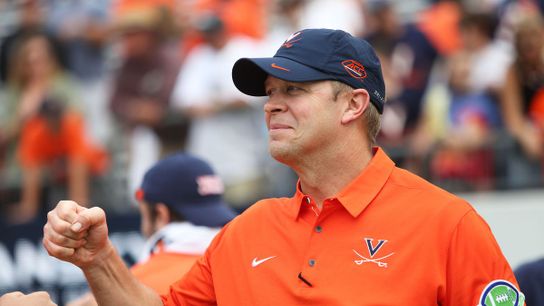We're not talking much about Virginia football right now -- when was the last time we did, honestly? -- but that could change by Saturday evening.
The 18th-ranked Cavaliers travel to No. 10 Notre Dame (3:30 p.m. ET, NBC) for the program's biggest game since... well, I couldn't tell you. Virginia is the only Coastal Division team yet to play in the ACC Championship (which began back in 2005), and while Saturday's tilt is a non-conference game, it'll go a long way toward showing if Virginia actually has the goods to win its first division title and serve as more than just a speed bump on Clemson's drive to a fifth straight ACC crown.
As Virginia stands at the brink of national relevance for the first time in 15 years, it's worth assessing how they got there.
Remember, it was a surprising move at the time when Bronco Mendendhall cashed in his 11-year run and 99-43 record at BYU for a new challenge. As ESPN's Edward Aschoff describes it, Mendenhall had three requirements for his new job:
The program had to be "awful," the program had to care about something other than football and he wanted to be in a Power 5 conference.
"I got exactly that," Mendenhall told ESPN last week.
When Mendenhall arrived, Virginia had endured four straight losing seasons -- 4-8 in 2012, 2-10 in '13, 5-7 in '14 and 4-8 in '15. Virginia has never been confused with its football-mad neighbor Virginia Tech and the program is a long, good-standing member of the ACC. Check, check and check.
When a program goes 15-33 over a 4-year span, a lot has to go wrong on the field, obviously. But the fix won't, and can't, come simply through improved recruiting, sharper Xs and Os and tougher practices. It takes more than that. You have to turn around the morale and the culture of the program.
To do that, Mendenhall and his staff installed a system where players would wear color-coded shirts that correspond to their standing in the program. Below average players wear white, average players wear gray, and rising from there to the top level, black.
There's nothing novel about that. In fact, we did that at my small, private high school way back when. But what caught my attention was the level of effort players were willing to put in to level up.
To graduate from colors, players have to meet certain numbers during their workouts, but even after that, they're sent on a "rite of passage" that features different weight packs to be worn through stadium steps and "mountains to climb" before they can grab their new color.
"It's amazing what a T-shirt means once they've done all that," Mendenhall said. "It's a big deal."
Mendenhall also installed a similar system when it came to picking jersey numbers, leaving it up to the players to decide the order in which their peers get to select their numbers.
"So if Coach Mendenhall loves a certain player and thinks he should start, but the guys don't think he's earned his number through offseason workouts, practice, performance, how he handles himself, then he doesn't get his number," said junior linebacker Charles Snowden, who is on the task unit and went from No. 38 as a freshman to No. 11 the last two years.
Making players earn their gear created a buy-in to the point where Virginia is now reaching heights unseen since 2004, when the program started 5-0 and reached No. 6 in the AP poll.
